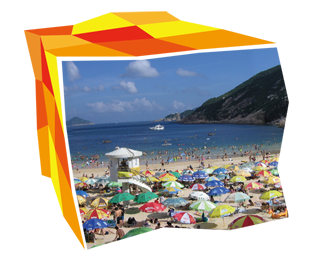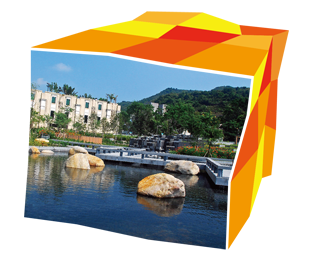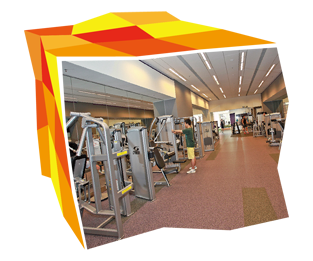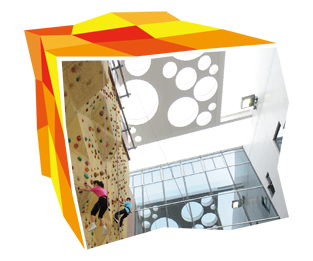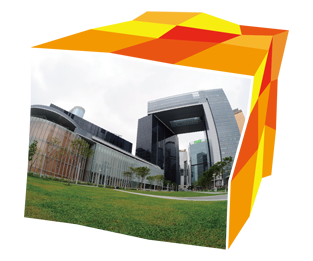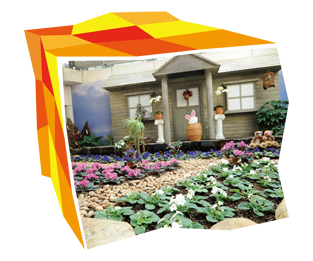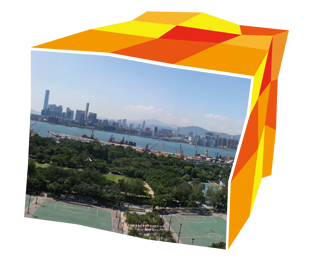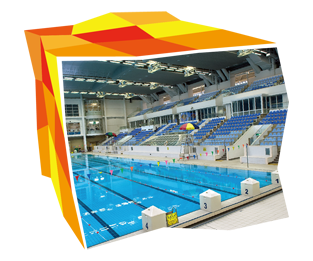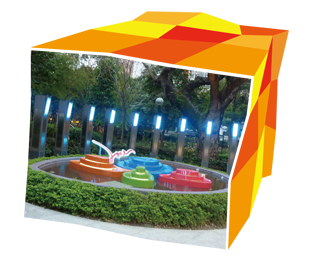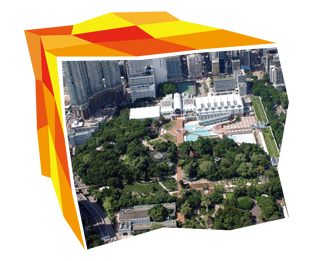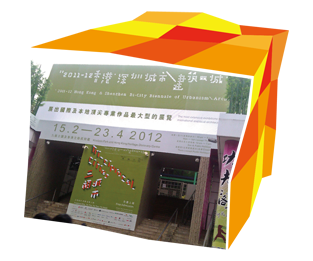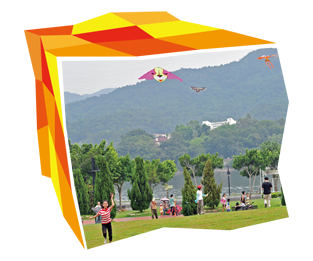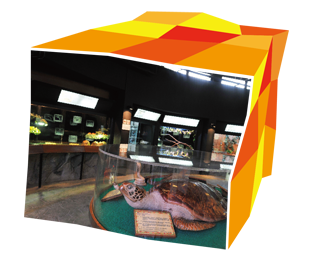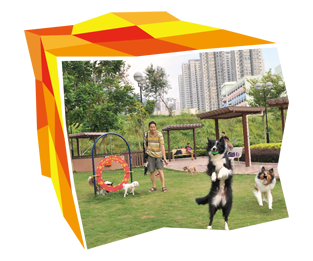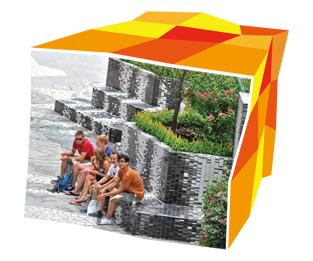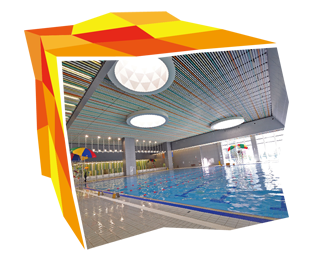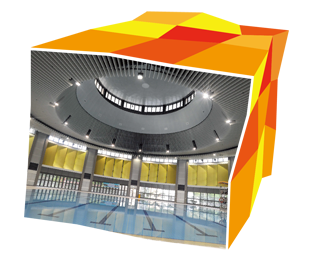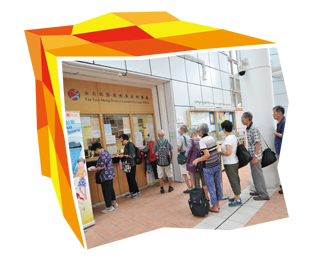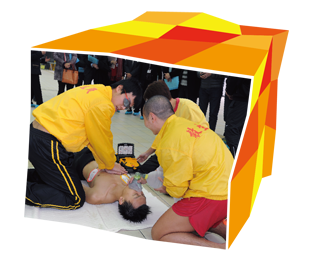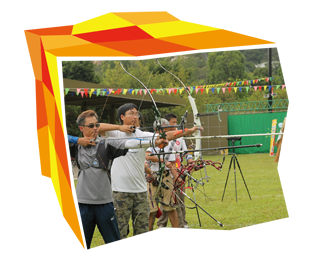Recreational and Sports Facilities
The sports facilities and other amenities in Hong Kong’s 18 districts comprise 41 gazetted beaches, 43 swimming pools, two outdoor stadia (Hong Kong Stadium and Mong Kok Stadium), 47 natural turf soccer pitches, 30 artificial turf soccer pitches, 231 hard-surface soccer pitches, two hockey pitches, two rugby pitches, 94 sports centres, 290 squash courts, 25 sports grounds, 256 tennis courts, four golf driving ranges, five water sports centres, four holiday camps, 25 major parks, and 694 children’s playgrounds. These leisure facilities cover a total area of 2 292 hectares.
Hang Hau Man Kuk Lane Park, which covers an area of around 1.9 hectares, has been opened to the public in phases since November 2011. Featuring white walls and grey rooftops, the park design reflects a construction style characteristic of Suzhou and Hangzhou. A key feature of the park is the contemporary-styled Chinese Garden, nestled in the south-eastern corner of the venue. At its centre are water features set in an interplay with a pavilion made in a style resembling traditional bamboo scaffolding. The stone bridge, rockscape and Zen garden blend harmoniously with the water features and pavilion, giving visitors a scene to delight in.
Hang Hau Sports Centre, which has opened to the public in phases since December 2011, is the newest sports centre in Sai Kung District. It is situated on the first to the third floors of the Sai Kung Tseung Kwan O Government Complex. The Sports Centre includes a multi-purpose arena with two basketball courts, two volleyball courts or eight badminton courts, three multi-purpose activity rooms, one table-tennis room, one children’s play room, one fitness room, an indoor jogging track, and other ancillary facilities. The 150-metre indoor jogging track is the first of its kind in Sai Kung District, and provides runners with an all-weather environment for jogging. The fitness room, with more than 30 sets of fitness equipment and the largest of its kind in Sai Kung District, has been well-received by the public. The booking counter has adopted an open counter design, the first of its kind in the department, which helps create a friendly and welcoming atmosphere and improves communication with members of the public. If required, the three activity rooms can be combined into one large 480 square metre activity room. Hang Hau Sports Centre has become one of the most popular sports centres in Sai Kung District. Usage of the multi-purpose arena from January 2012 to February 2013 averaged over 90% in peak hours, and over 70% in non-peak hours. The multi-purpose arena, suitable for holding large-scale events, has seating for 1 200 spectators and a new high definition LED display measuring 7.5 metres by 4.4 metres.
The Hong Kong Velodrome, which is expected to open in early 2014, consists of both indoor and outdoor facilities covering 1.3 hectares and 5.3 hectares respectively. The indoor facilities at the velodrome are the first of their kind in Hong Kong, and the indoor cycling track is designed to meet the International Cycling Union’s Class I standard. The velodrome has one 250-metre wooden cycling track with supporting facilities suitable for hosting international competitions, a permanent spectator stand providing 2 000 seats (which can be expanded to 3 000 when needed), and a multi-use arena in the infield area at track level for two basketball / volleyball courts or eight badminton courts. Other than hosting cycling events up to world cup level, the facilities can also be used for staging other major non-sports events such as entertainment performances, exhibitions and conferences. In particular, the venue will serve as a major training base for top-level cycling training for the Hong Kong Cycling Team, and other elite cyclists from the Hong Kong Sports Institute and the Hong Kong Cycling Association. It will also act as a multi-purpose sports centre where the local community can play a range of indoor sports and ball games. The velodrome’s outdoor facilities, which include both active and passive leisure and recreational facilities, will also benefit the local community. Its active recreational facilities include a skateboard park, an outdoor climbing wall, a jogging track, fitness corners and a children’s play area, while its passive leisure facilities include an open-air amphitheatre, an artificial lake, a model boat pool, a lawn area, and a landscaped terrace.
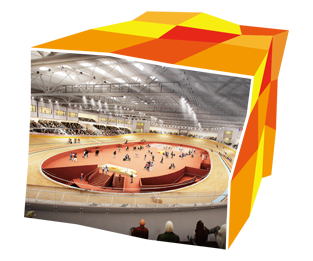 |
The indoor cycling track at the Hong Kong Velodrome has been designed to meet the International Cycling Union’s Class I standards. |
| (artist's impression) | |
The Po Wing Road Sports Centre was opened for public use in March 2012, providing residents in the North District with the most advanced facilities in the district. It features the district’s first outdoor sports climbing wall, and its only indoor jogging track. Other facilities include a table-tennis room, an American pool room, a fitness room, a children’s play room, two activity rooms, and a multi-purpose arena which can be converted into two basketball courts / volleyball courts, or eight badminton courts. The arena has a 1 200-seat spectator stand, and is suitable for holding large-scale sports events.
On Lok Mun Street Playground (skateboard ground), which opened in November 2011, provides the largest skating park in Hong Kong. The playground covers 2 204 square metres, including 1 330 square metres of play area. Suitable for advanced skateboard players and for high level training, its skateboarding equipment and structures conform to all relevant safety standards and include three bowls, eight platforms, two ramps, and three play rails. There is also a spectator stand with a rain shelter and seating.
Parks
The LCSD manages more than 1 540 parks and gardens of different sizes, including the following major parks:
Tamar Park
Tamar Park, adjacent to the new Central Government Offices and the Legislative Council Complex, covers an area of around 1.76 hectares. The park has opened to the public in phases since October 2011, and includes a landscaped garden, water features, a floating platform, an amphitheatre, Tamar Corner, and Tamar Café. Its spacious green lawns provide valuable open space and broad views of the Victoria Harbour.
Hong Kong Park
Hong Kong Park, covering 8.16 hectares, was opened in May 1991 on the former Victoria Barracks site. Major attractions include a conservatory, an aviary, a squash centre, a sports centre, a children’s playground, a vantage point, a restaurant and the Olympic Square.
The aviary, simulating a tropical rainforest, is home to around 600 birds of 80 different species. Several of these species bred successfully during the year, specifically the Bali Myna, Java Sparrow, Zebra Dove, Nicobar Pigeon, Maroon-breasted Crowned Pigeon, Black-capped Lorry, Racket-tailed Treepie, and White-rumped Shama. The conservatory comprises a Display Plant House, a Dry Plant House and a Humid Plant House, all of which have environmental controls that simulate different climatic conditions for plants from arid and tropical regions. A ‘Herbs and Spices’ show was held at the Display Plant House from April to November 2012. More than 580 plants of over 40 species were put on display, together with nearly 20 kinds of herb and spice products. From November 2012 to March 2013, a thematic exhibition of African Violets was held, involving more than 300 pots of African Violets and a variety of species. These included some special species classified in terms of flower type (such as Fantasy, Two-tone, and Chimera) and leaf type (such as Wavy and Variegated).
Victoria Park
Victoria Park, which was first opened in October 1957, is one of the most popular parks in Hong Kong. Apart from serving as an attractive venue for sports and leisure activities, the 19.3-hectare park is a popular spot for community events that draw hundreds of thousands of visitors every year, such as the annual Lunar New Year Fair, the Hong Kong Flower Show, and the Mid-Autumn Lantern Festival.
Kowloon Park
The 13.3-hectare Kowloon Park, which served as a military camp during the 1860s, was converted into an urban park in 1970. Redeveloped by the former Royal Hong Kong Jockey Club, the park took its present shape in 1989. Located in the heart of Tsim Sha Tsui, it is the largest park in Kowloon and provides an array of indoor and outdoor recreational facilities, including a hard-surface soccer pitch, a sports centre and a swimming pool complex.
Occupying an area of around three hectares, the Kowloon Park Swimming Pool can hold up to 1 469 swimmers. Average annual use over the past three years has exceeded 800 000. One of the best-equipped swimming pools in Hong Kong, it serves as a major training and competition venue for many international aquatic events. In December 2009, for example, the Kowloon Park Swimming Pool was a venue for the aquatic events of the 2009 East Asian Games in Hong Kong.
To celebrate their successful achievements at the London 2012 Olympic Games, on August 25, 2012 Mainland gold medallists displayed their superb skills in a series of diving demonstrations held at the Kowloon Park Swimming Pool. The event was also a celebratory event to commemorate the 15th anniversary of the establishment of the HKSAR. Besides putting on a spectacular display for the public, the gold medallists took time to chat with some of the young people attending. The event also featured lucky draws, with a few lucky spectators winning T-shirts autographed by the national diving team.
In addition to its sports facilities, the park has a number of gardens and walks. The Garden of Life was unveiled in November 2011 to acknowledge the generosity of organ donors and their families. The garden’s special landscape design and architecture echoes the organ donation theme, ‘Light Up Lives’.
The Sculpture Walk features permanent and temporary displays by both local and overseas artists, including the Concept of Newton, a permanent sculpture by Eduardo Paolozzi. A 240-metre tree walk introduces 35 of Hong Kong’s most common flowering tree species.
Another significant attraction is the landscaped bird lake and aviary, with its flock of more than 100 flamingos and many other bird species.
The park hosts a number of major events throughout the year, including Kung Fu Corner and the Arts Fun Fair, held on Sundays and/or public holidays. Regular morning bird watching activities are organised to introduce the public to the common bird species in the park. District-wide community events such as carnivals, outdoor exhibitions and entertainment events are regularly held at the piazza, attracting hundreds of thousands of locals and tourists over the year.
One of Kowloon Park’s event highlights of the year was the setting up of the Avenue of Comic Stars. Organised by the Hong Kong Comics & Animation Federation Limited and set to last for three years, the Avenue of Comic Stars aims to promote and publicise Hong Kong’s comics industry to the world. Its goals are to establish the status and image of Hong Kong comics, to recognise the outstanding achievements of Hong Kong cartoonists, and in the process to become a significant tourist attraction.
Another notable event was the ‘2011-12 Hong Kong & Shenzhen Bi-City Biennale of Urbanism / Architecture’, held in Kowloon Park from January 3 to May 4, 2012. The event was organised by the Hong Kong Institute of Architects to promote the appreciation of Hong Kong architecture and art, and included an exhibition, a range of organised activities, and a ceremony. Many innovative and creative exhibits were erected in Kowloon Park as part of the event, attracting thousands of visitors.
Tai Po Waterfront Park
The 22-hectare Tai Po Waterfront Park is the largest park managed by the LCSD. Its 32-metre Spiral Lookout Tower gives visitors a panoramic view of Tolo Harbour and the surroundings. Other facilities include a 1 000-metre promenade, an insect house, an amphitheatre, a central water feature, a sheltered viewing terrace, children’s play areas, bowling greens, a gateball court, and a kite-flying area. The park also has a number of themed gardens, including a Floral Display Garden, a Scented Garden, a Malvaceae Garden, a Western Garden, an Ecological Garden, a Palm Garden, a Herb Garden, a Fig Garden and a Camellia Garden.
Tuen Mun Park
Tuen Mun Park was the first major park in the New Territories to provide a wide range of facilities. Phases I, II and III opened to the public in 1985, 1988 and 1991 respectively.
Built on reclaimed land, this 12.5-hectare park holds more than 2 000 trees and 120 000 shrubs of various species. The one-hectare artificial lake is a popular spot, as is the Reptile House, which attracts 360 000 visitors annually, including 38 000 group visitors.
Other facilities include a water cascade, a model boat pool, an amphitheatre, a roller-skating rink, three children’s playgrounds, a fast food kiosk, a conservation corner, a sitting-out area for the elderly, four pebble walking trails, pavilions, and a multi-game area.
Pet Gardens
The LCSD has responded to the increase in the number of dog owners in Hong Kong by opening more pet gardens. At present, 29 of its leisure venues have pet gardens. In consultation with DCs, the department will continue to identify suitable sites for building further pet gardens.
Play Equipment for All Children
The equipment in most of the playgrounds managed by the department is suitable for all children, including those with disabilities. Last year, the department installed large ‘inclusive’ play areas for children in Morse Park, Ap Lei Chau Park and Yuen Shin Park. The play apparatus installed provides barrier-free access, while the integrated design encourages harmony and inclusiveness among children when they play. The department plans to provide more such facilities in the future.
Park Déco Trial Scheme (Cornwall Street Park)
To enhance their appeal, the LCSD is implementing projects under the Park Déco scheme in selected parks, installing creative park furniture and signage with friendly advice and positive messages. The first trial project, at Quarry Bay Park, was completed in May 2011, and a second trial project, at Cornwall Street Park, in September 2012. At Cornwall Street Park, three sets of new park furniture and a new signage system were installed, and the Park was refurbished under the linking theme of ‘Inspirational Flow’. A launch ceremony was held on September 4, 2012 at the Park.
Design parameters drawn up after the completion of this project will serve as a useful reference for the department’s existing parks, and for future park projects.
Beaches and Swimming Pools
Hong Kong people made more than 12.60 million visits to beaches and 10.81 million visits to public swimming pools managed by the department in 2012-13. Two new swimming pool complexes – Lam Tin Swimming Pool and Tuen Mun North West Swimming Pool – opened during the year. The conversion of the secondary pool at Lai Chi Kok Park Swimming Pool into an indoor heated pool was completed in June 2012.
The newly built Lam Tin Swimming Pool, opened for public use in November 2012, is the first indoor swimming pool in the Kwun Tong District. It provides two indoor heated swimming facilities, one measuring 25m x 25m and the other 25m x 10m.
The Tuen Mun North West Swimming Pool was opened for public use in December 2012. It is the first swimming pool in Tuen Mun to have indoor heated pool facilities and a jacuzzi. It also has an indoor training pool measuring 25m x 25m, and an indoor leisure pool. The swimming pool complex also offers a standard main pool measuring 50m x 25m, a training pool measuring 25m x 15m, and a teaching pool measuring 25m x 12m. The main pool has a spectator stand with around 800 seats, and is suitable for hosting swimming competitions.
Water quality at the three beaches in Tsuen Wan – Anglers’ Beach, Gemini Beaches and Ting Kau Beach – has improved. The beaches will be reopened once essential improvement works have been completed.
The department introduced a Public Swimming-Pool Monthly Ticket Scheme in early July 2012. The scheme is designed to make swimming cheaper for regular swimmers, especially the elderly, and to encourage more people to swim regularly. Recently, a smart card system has been installed that adds convenience by enabling swimmers to enter the pool using their smart cards.
To promote water sports safety, the department co-organised a series of campaigns and activities during the year in collaboration with the Hong Kong Life Saving Society and other relevant departments.
The department also organised a swimming pool cleaning campaign for children aged 11 and below and their parents.
Water Sports Centres and Holiday Camps
The LCSD manages five water sports centres (Chong Hing, Stanley Main Beach, St Stephen’s Beach, Tai Mei Tuk and Wong Shek) and four holiday camps (the Lady MacLehose Holiday Village, Sai Kung Outdoor Recreation Centre, Tso Kung Tam Outdoor Recreation Centre and Lei Yue Mun Park and Holiday Village). During the year, 125 000 people participated in programmes at the water sports centres, while 555 520 enjoyed the facilities at the holiday camps. The department also organises evening camps so people can participate after office hours; a total of 39 991 people took part in these during 2012-13.
Stadia
Hong Kong Stadium, with a capacity of 40 000, is a major venue for sports and community events. During the year, 33 events were held, attracting a combined audience of 304 000. Major events included an invitation football match between Kitchee and Arsenal Football Club, the Mainland Olympic Gold Medallists Extravaganza, the East Asian Football Federation East Asian Cup 2013 Preliminary Competition Round 2, the China Mobile Satellite Communications Cup, and the famous Hong Kong Sevens. A range of other footballing and community events were also held. After redevelopment, the Mong Kok Stadium was reopened in October 2011. With a seating capacity of 6 668, it serves as one of the major venues for the First Division Football League and the training ground for the national squad. A total of 86 events were held at the stadium in 2012-13, including the Asian Football Confederation Cup among Hong Kong, Thailand, Myanmar and Singapore, the Asian Five Nations Rugby Match between Hong Kong and Kazakhstan, and the Asian Cup 2015 Qualifying Round between Hong Kong and Vietnam. A total of 274 839 spectators were attracted this year.
Automated External Defibrillators (AEDs) at Major Land-based Facilities
The department plans to assist victims of cardiac arrest by introducing AEDs at all fee charging and non-fee charging land-based facilities with active sports facilities, and at all cultural venues. Public access will be available in emergencies. An implementation plan had been drawn up with the aim of installing AEDs by mid 2013 at all major land-based venues providing active sports facilities, and cultural venues.
Venue Management Initiatives and Improvements
Work Improvement Teams
By the end of March 2013, we had set up 291 Work Improvement Teams in district leisure venues to carry out self-initiated and departmental improvements. Given the success of this scheme, the department will continue to support these teams at all major leisure venues, including sports centres, swimming pools, beaches, parks and playgrounds.
Free Use Scheme
The Free Use Scheme aims to maximise the use of recreational facilities by allowing eligible organisations free access to the main arenas and activity rooms of all sports centres, squash courts, hockey pitches, outdoor bowling greens and obstacle golf courses during non-peak hours from September 1 to June 30 of the following year. Eligible organisations include schools, National Sports Associations, district sports associations and subvented non-governmental organisations.
LCSD Leisure Link
Launched in 2002, the Leisure Link System enables the public to book leisure facilities and enrol in community recreation and sports programmes either online, over the telephone, or at booking counters throughout the territory. In 2008 the department introduced self-service kiosks, which allow people to easily book leisure facilities or enrol in programmes using their Smart Identity Cards, and to pay by Octopus card. Currently 47 LCSD venues have self-service kiosks, with nine on Hong Kong Island, 15 in Kowloon, and 23 in the New Territories.
Counter services were provided at 156 recreational venues, where the public could book facilities, enrol in recreational programmes and get help with facilities and sports programmes.
Facilities for National Sports Associations
The department provides National Squad Training Centres for 38 associations, encouraging the use of LCSD facilities and providing a wide range of training opportunities for individual athletes and national squads.

 Print
Print